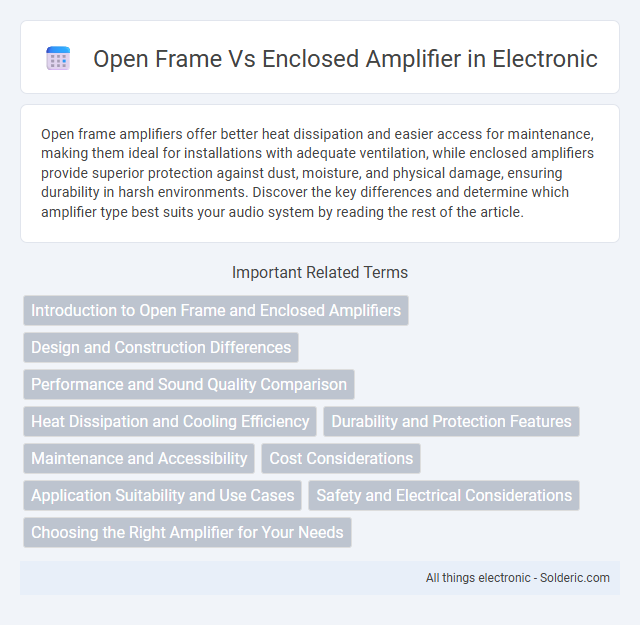Open frame amplifiers offer better heat dissipation and easier access for maintenance, making them ideal for installations with adequate ventilation, while enclosed amplifiers provide superior protection against dust, moisture, and physical damage, ensuring durability in harsh environments. Discover the key differences and determine which amplifier type best suits your audio system by reading the rest of the article.
Comparison Table
| Feature | Open Frame Amplifier | Enclosed Amplifier |
|---|---|---|
| Design | Exposed circuitry, minimal casing | Fully enclosed in protective housing |
| Cooling | Natural or forced air cooling | Often includes integrated cooling systems |
| Durability | Less protected, vulnerable to dust and physical damage | Robust protection against environmental factors |
| Installation | Requires careful handling during setup | Easier to install with plug-and-play setup |
| Application | Best for controlled environments like labs | Ideal for industrial and harsh environments |
| Cost | Generally lower cost | Higher cost due to rugged housing |
| Maintenance | Easier access for repairs and modifications | More complex due to sealed design |
Introduction to Open Frame and Enclosed Amplifiers
Open frame amplifiers feature a compact design with exposed components, allowing improved heat dissipation and ease of integration into custom electronic systems. Enclosed amplifiers provide a protective casing that offers enhanced durability, shielding against dust, moisture, and electromagnetic interference. Choosing between open frame and enclosed amplifiers depends on application requirements such as thermal management, environmental exposure, and mechanical protection.
Design and Construction Differences
Open frame amplifiers feature exposed circuit boards and components, allowing for better heat dissipation but increased vulnerability to dust and physical damage. Enclosed amplifiers are housed within protective casings that shield components from environmental factors and enhance durability, often incorporating built-in fans or heat sinks for thermal management. The design choice impacts both cooling efficiency and protection level, directly influencing amplifier lifespan and performance stability.
Performance and Sound Quality Comparison
Open frame amplifiers typically offer better heat dissipation, which supports consistent performance during extended use, while enclosed amplifiers may experience more heat-related performance degradation. Sound quality in open frame models often benefits from reduced electromagnetic interference due to their exposed design, leading to cleaner, more accurate audio reproduction. Your choice between the two should consider whether superior thermal management and sound clarity or enhanced durability and protection align better with your audio needs.
Heat Dissipation and Cooling Efficiency
Open frame amplifiers offer superior heat dissipation due to their exposed design, allowing air to flow freely across heat-generating components, which significantly enhances cooling efficiency. In contrast, enclosed amplifiers often rely on built-in fans or heat sinks to manage thermal buildup, which can be less effective and sometimes noisier. Effective thermal management in open frame models leads to improved reliability and longer component lifespan, especially in high-power applications.
Durability and Protection Features
Open frame amplifiers offer exposed internal components, making them more susceptible to dust, moisture, and physical damage, which can affect durability in harsh environments. Enclosed amplifiers provide robust protection with sealed casings that guard against environmental factors like humidity, dust, and mechanical impact, enhancing longevity and reliability in industrial or outdoor applications. The choice between open frame and enclosed amplifiers depends on the required level of protection and the operating conditions to ensure optimal device durability.
Maintenance and Accessibility
Open frame amplifiers offer superior maintenance and accessibility due to their exposed components, making it easier to perform repairs and upgrades without disassembly. Enclosed amplifiers provide better protection from dust and environmental factors but often require more time and tools to access internal parts for servicing. Your choice between the two depends on the balance you need between ease of maintenance and environmental protection.
Cost Considerations
Open frame amplifiers typically offer a more cost-effective solution due to simpler construction and fewer materials used compared to enclosed amplifiers. Enclosed amplifiers provide enhanced protection and durability, which can justify a higher initial investment for applications requiring robust reliability. Your choice should weigh upfront costs against long-term value based on the operating environment and maintenance needs.
Application Suitability and Use Cases
Open frame amplifiers are ideal for integration within electronic devices where space constraints and internal cooling suffice, commonly used in consumer electronics and embedded systems. Enclosed amplifiers offer robust protection against dust, moisture, and mechanical damage, making them suitable for industrial automation, outdoor installations, and harsh environment applications. Selecting the appropriate amplifier type depends on the application's environmental exposure, thermal management needs, and mechanical durability requirements.
Safety and Electrical Considerations
Open frame amplifiers expose internal components, increasing the risk of accidental electrical shock and requiring strict compliance with insulation and clearance standards. Enclosed amplifiers provide enhanced protection from environmental hazards and reduce electrical hazards by isolating live parts within a grounded metal or plastic housing. Safety certifications such as UL, CE, and IEC standards are more commonly met by enclosed designs due to their superior containment of electrical risks.
Choosing the Right Amplifier for Your Needs
Open frame amplifiers offer better heat dissipation and are ideal for applications requiring easy access for maintenance, while enclosed amplifiers provide enhanced protection against dust and moisture, making them suitable for harsh environments. Your choice depends on the operating environment and cooling requirements, with open frame designs favoring controlled indoor settings and enclosed models ensuring durability in industrial or outdoor conditions. Consider power output, installation space, and environmental factors to select the amplifier that best meets your performance and reliability needs.
open frame vs enclosed amplifier Infographic

 solderic.com
solderic.com